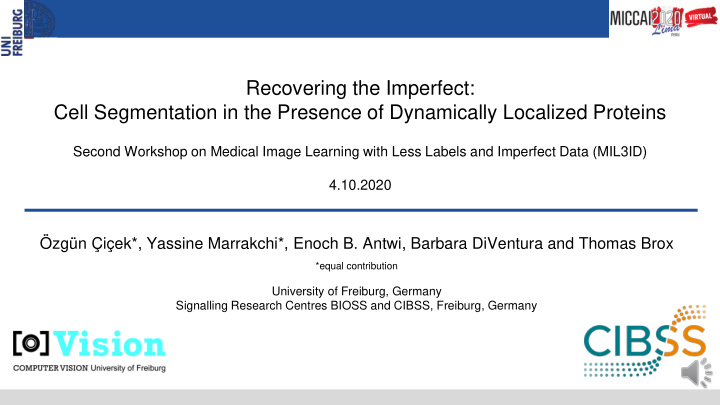



Recovering the Imperfect: Cell Segmentation in the Presence of Dynamically Localized Proteins Second Workshop on Medical Image Learning with Less Labels and Imperfect Data (MIL3ID) 4.10.2020 Özgün Çiçek*, Yassine Marrakchi*, Enoch B. Antwi, Barbara DiVentura and Thomas Brox *equal contribution University of Freiburg, Germany Signalling Research Centres BIOSS and CIBSS, Freiburg, Germany
Motivation ● The dynamic localization patterns of proteins dictate their function. ● Biologists use optogenetics to control protein localization via light exposure. ● Repeatedly giving light creates oscillations of the protein in and out of the nucleus. ● These oscillations cause regular and temporary deterioration in visibility. ● Deep learning methods become unreliable when the visibility is drastically deteriorated. Time-lapse confocal images of HEK293T cells with fusion protein mCherry-LINuS
Related Work ● We are first to address segmentation of oscillatory fluorescent signal in videos. ● Video segmentation methods explore temporal propagation of features in their design. ● Our task is different: ○ Dense annotation in time for imperfect data is tedious. ○ We are solely interested in structures with limited visibility.
Our Contribution ● Mask R-CNN (He et al., 2017) with uncertainty to detect erroneous predictions. ● Optical flow to refine detected errors by propagating certain predictions from neighboring frames. Oscillation at time t causing bad nuclei segmentation (up) and the corrected segmentation of it using our propagation method (down).
Our Approach - Mask R-CNN with Uncertainty Estimation ● Data uncertainty ○ Combining Mask R-CNN (He et al., 2017) with data uncertainty estimation (Kendall and Gal, 2017) Overview of Mask R-CNN with added data uncertainty. Changes to the original architecture are shown in red (operations) and green (outputs).
Our Approach - Mask R-CNN with Uncertainty Estimation ● Model uncertainty ○ Combining Mask R-CNN with model uncertainty estimation (following Ilg et al., 2018) training testing ■ Dropout: Mask R-CNN Mask R-CNN Mask R-CNN Mask R-CNN Mask R-CNN dropout dropout dropout dropout dropout ■ Ensemble: Mask R-CNN Mask R-CNN Mask R-CNN Mask R-CNN Mask R-CNN Mask R-CNN Mask R-CNN Mask R-CNN Mask R-CNN Mask R-CNN Mask R-CNN Mask R-CNN Mask R-CNN ■ SGDR Ensemble: Mask R-CNN Mask R-CNN ■ Winner-Takes-All: merge merge Mask R-CNN Mask R-CNN merge merge ■ Evolving WTA: (Makansi et al., 2019)
Our Approach - Uncertainty-Based Nuclei Mask Propagation Oscillation at time t causing bad nuclei segmentation (up) and the corrected segmentation of it using our propagation method (down). Traverse the video in increasing average uncertainty order: no propagation: one-sided propagation: double-sided propagation: * * * not more not more more not more more more certain certain certain certain certain certain time time time
Our Approach - Uncertainty-Based Nuclei Mask Propagation Oscillation at time t causing bad nuclei segmentation (up) and the corrected segmentation of it using our propagation method (down). Traverse the video in increasing average uncertainty order: no propagation: one-sided propagation: double-sided propagation: * * * not more not more not more not more more more certain certain certain certain certain certain time time time
Our Approach - Uncertainty-Based Nuclei Mask Propagation Oscillation at time t causing bad nuclei segmentation (up) and the corrected segmentation of it using our propagation method (down). Traverse the video in increasing average uncertainty order: no propagation: one-sided propagation: double-sided propagation: * * * not more not more not more not more not more not more certain certain certain certain certain certain time time time
Our Approach - Uncertainty-Based Nuclei Mask Propagation Oscillation at time t causing bad nuclei segmentation (up) and the corrected segmentation of it using our propagation method (down). Traverse the video in increasing average uncertainty order: no propagation: one-sided propagation: double-sided propagation: * * * not more not more not more not more not more not more certain certain certain certain certain certain time time time *Traversing continues with the updated masks and uncertainties to facilitate long propagation horizon.
Our Approach - Uncertainty-Based Nuclei Mask Propagation Oscillation at time t causing bad nuclei segmentation (up) and the corrected segmentation of it using our propagation method (down). Traverse the video in increasing average uncertainty order: no propagation: one-sided propagation: double-sided propagation: * * * not more not more not more not more not more not more certain certain certain certain certain certain time time time *Traversing continues with the updated masks and uncertainties to facilitate long propagation horizon.
Results - Uncertainty Estimation Uncertainty Evaluation in mAP (@0.5/@0.75 IoU):
Results - Propagation Algorithm Propagation Evaluation in mean IoU: Our method can effectively improve erroneous nuclei predictions.
Results - Qualitative Examples Extreme Signal Loss: Raw Time-Series: Initial Masks: Uncertainty Maps: Refined Masks: time
Conclusions ● We introduce the recent uncertainty estimation methods to cell instance segmentation. We solve a real task commonly experienced in signalling studies which is not yet addressed. ● ● Our method improves nuclei segmentation over several baselines. ● Our method can facilitate automated analysis of dynamically localized proteins without additional markers.
Thank you! & Questions? Poster and Code: This project was funded by the German Research Foundation (DFG) and the German Ministry of Education and Science (BMBF). Gefördert durch die Deutsche Forschungsgemeinschaft (DFG) im Rahmen der Exzellenzstrategie des Bundes und der Länder – EXC-2189 – Projektnummer 390939984 und durch das Bundesministerium für Bildung und Forschung (BMBF) Projektnummer 01IS18042B und 031L0079.
Recommend
More recommend